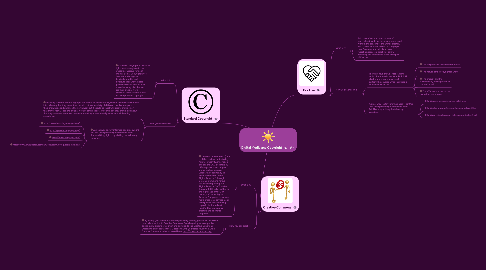
1. Standard Copyright
1.1. What is it?
1.1.1. Standard Copyright is the set of rights which are given to the creators of various forms of original media. Copyright gives the creator the right to distribute, modify and distribute their work. It also gives the creator control over how others may distribute or use their original work. However, there are limitations and exceptions to copyright.
1.2. How you can teach it:
1.2.1. Teaching students about Copyright law should be done carefully! It should not scare students into believing that they cannot and should not use a variety of different medias to expand their knowledge and enhance their own work but it should be taught. Students should know that they CANNOT call the original work of others theirs, of course, but they should also know that they can use a variety of content created by others to really enhance their learning experience.
1.2.2. A great way to stay informed about copyright law and to help inform your students about Standard Copyright is by visiting the following websites:
1.2.2.1. http://www.teachingcopyright.org/
1.2.2.2. http://questioncopyright.org/
1.2.2.3. http://www.copyright.gov/
1.2.2.4. http://www.lawupdates.com/law/copyright_new-judicial-opinions
2. Creative Commons
2.1. What is it?
2.1.1. Creative Commons (CC) is a tool that is aimed at fostering "digital creativity, innovation and sharing". CC does this by offering creators of original works, such as songs or videos, the opportunity to deem their works "Some Rights Reserved" through Creative Commons versus the all encompassing "All Rights Reserved" of Standard Copyright. CC believes that in the digital age of the 21st century, a "Some Rights Reserved" approach creates a more productive environment in respect to content being copied, distributed and modified for educational creative and scientific purposes.
2.2. How you can teach it:
2.2.1. By having your class create an original story or song, you could show them how to license it with Creative Commons. Even by giving an example like taking a silly picture of yourself and going on to the Creative Commons website to demonstrate the CC licensing with your class could work well! Creative Commons ca be accessed here: http://creativecommons.org/ .
3. Fair Use
3.1. What is it?
3.1.1. Fair Use defines the types of uses of copyrighted works which are perfectly legal without the consent of the work's creator. Fair Use is a doctrine within US Copyright Law. Commentary, criticism, news reporting, research, teaching, library archiving and scholarship are all examples of Fair Use.
3.2. How you can teach it!
3.2.1. There are four IMPORTANT factors which determine is a work is FAIR USE eligible and these should most certainly be covered when instructing students on Fair Use.
3.2.1.1. The purpose and the character of use
3.2.1.2. The nature of the copyrighted work
3.2.1.3. The amount and the sustainability of the portion of the work used
3.2.1.4. The affect of the use on the market for the original
3.2.2. A great way to stay informed about Fair Use and to help inform your students about Fair Use is by visiting the following websites:
3.2.2.1. http://centerforsocialmedia.org/fair-use
3.2.2.2. http://cyberlaw.stanford.edu/taxonomy/term/374
3.2.2.3. http://www.teachingcopyright.org/curriculum/hs/3
